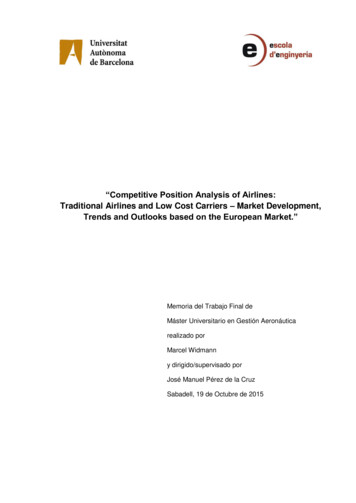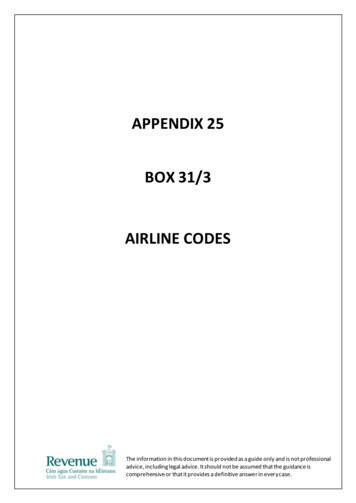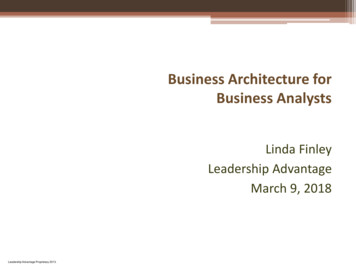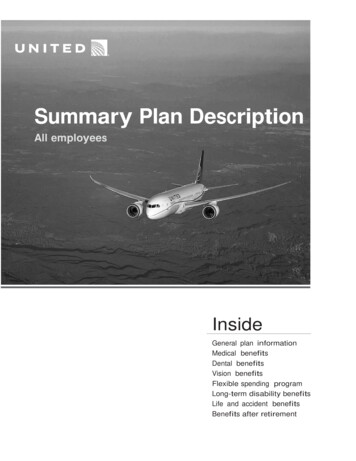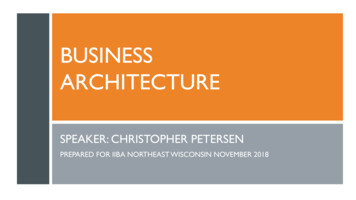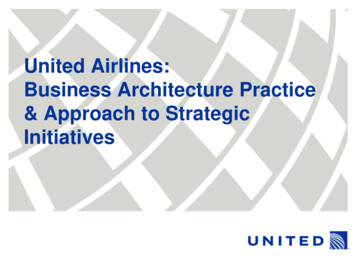
Transcription
United Airlines:Business Architecture Practice& Approach to StrategicInitiatives
Why Business ArchitectureDue to the growing complexity of business today, activities such as mergers andacquisitions, right sizing and regulatory compliance activities, organizations must findopportunities to become stronger, more efficient and effectiveBusiness Architecture helps by describing the key capabilities that bring value to theenterprise. The value comes from answering critical questions such as; What capabilities support our corporate strategies and objectives What roles and organizations enable those capabilities How will the business need to change in order to support the strategic directionThe answer to those and other questions enables the enterprise to re-use knowledgeeffectively and understand the critical integration points between capabilities and thustheir supporting systems.2
Business Architecture helps bridge the gap between Strategy and Execution, playing animportant role in Strategic and Project AnalysisIllustrative Purposes OnlyStrategic PlanningUnderstandBusiness VisionDefine IT GoalsCommunicateIT StrategyMonitor & AdaptIT StrategyPrioritize terpriseApplicationArchitecture Connects United’sbusiness strategies toenterprise capabilities Aligns project work toenterprise goals andstrategies Conducts Impact/GapAnalysis (People,Process, Information,Metrics, Facilities) Creates roadmaps tobridge the gap to futurestate Establishes a commonframework for businessarchitecturedevelopment. Defines our technologystrategy. Manages the technologygovernance process &the referencearchitecture. Defines roadmaps tobridge the gap to futurestate for technologycapabilities. Facilitates developmentof architecture patternsand standards. Consults in design ofmultiple projects acrossmultipledisciplines/domainsProject oseout
Engagement ModelEngagementPointsKey to bridging this gap and answering the critical questions is the EngagementModelStrategic Discussions withBusiness and during ITStrategic Planning EffortsPortfolio Program/ProjectInceptionProgram and ProjectFeasibility Phases focusing onthose that introduce complexityand high degree of changeStrategic PlanGuidance/GovernancePrograms/Projects Associate Business and to Level2 capabilities provides holisticview and shared understandingof the impact Govern - Enterprise CapabilityModel Govern -Current/Future stateProcess/Workflows Insight at business capabilitylevel to Opportunities/Risks Govern - Capability Associationsrepresenting current state Provides Common BusinessArchitecture Framework aligningroles to processes toapplications, systems and dataflow Guidance - Impact Analysisregarding stakeholders,processes, and apps Guidance - High Level ScopeDefinition Alignment toPrograms/Projects enablestraceability to Enterprise goalsand measurements Requirement acceleration Process Optimization integratedwith systems and roles Identify Type and Degree ofChange to Capabilities & CriticalWorkflows (Drives if furtherEngagement is needed) UAT scenario accelerations Provide context for benefitestimation/metric identificationefforts4Create Enterprise Assets: Including Capability Associations for Roles, Processes, Applications andServices, Current/Future State Business Processes Models, Functional Impact Analysis and Crossfunctional interactions
The Enterprise Capability Model provides a Common Framework andUnderstanding of Business ContextCustomer1Customer Products &Marketing3Customer Pre-TravelExperience2SalesPre-Sale Experience8Network PlanningPre-Travel anagement4Customer AirportExperience5Customer InflightExperienceTravel Experience11Operations Control12Airport GroundOperations6Customer Relations7Customer LoyaltyManagementPost Travel Experience13Baggage Handling14AircraftMaintenanceThe United Customer ExperienceAStrategy & BusinessManagement5BHR ManagementCFinanceDExternal Relationships& yGSafety, Security, QAHProcurement & 3rdParty Suppliers
Strategic Analysis assessed at Level 2 Capabilities provides thefirst view of impactCustomer Travel ExperienceLevels 1 - 3Impact AnalysisEnhance Day of TravelExperience via technologyand self serviceWhat roles andorganizationsenable thosecapabilitiesIllustrative Purposes Only6Business ArchitectureAs-Is State
Understanding of Business Context is Everything Need scope, PLUS how it fits into the organizational, technical, andbusiness process context “Bottom up” approach assumes every process has a defined ownerand no cross divisional requirements Organizing by division, project, or technology often results inunidentified dependencies Dividing work into projects without up-front analysis yieldsincomplete scope and missing stakeholders
This understanding of context supports identifying how the BusinessCapability will change to achieve desired Business OutcomesIllustrative Purposes OnlyManage Customer Rebooking & RecoveryDescriptionPassenger flight protection and accommodations (i.e. meal, hotel,ground transportation) caused by irregular operations; includes allchannels and automationRoles Passenger, Agent, NOC, Contact CentersKPI Customer Satisfaction, Self Service Metrics, ProductivityStrategicOutcomes Reduce airport staffing for delayed flights Improve Customer Satisfaction with IRROP resolution time Consistently provide preferred service to preferred te the potential of change byconducting a gap analysis between as-is andto-beShift workload from Agent Channels to Self-Service ChannelsSimplify complex agent processesIncreased penetration of self service with customersExpand automated and self service booking options to satisfymore customer’s needs Apply Customer Information for IRROP prioritization ( 2013 GoForward Plan) Redesign Service Center to increase self service usage Expand available rebooking options to customers via self service Enable customer amenities via self service ( vouchers,compensation) Robust Search for first available (by cabin rather than class, .) Leverage In-flight channels for customer notification Wireless, touch screen capability to manage line waits Consider customer value when prioritizing linesHow will the businessneed to change inorder to support thestrategic directionChangeAnalysisBusiness ArchitectureTo-Be State8
Change includes opportunities: Addressing the Whole Plan projects and releases by looking at everything required to transform thecapability Illustrate how the capability will evolve Identify interfaces and actively manage them Maintain traceability from objectives to requirements
Traceability of Objectives to RequirementsObjectivesRequirementsConsistently provide preferredservice to preferred customersIntelligent QueuingImprove Customer Satisfactionwith IRROP resolution timeExpand Available RebookingOptions Via Self ServiceReduce airport staffing fordelayed flights
Gap Analysis Supports Integration of Systems and Project SpecificInitiativesGaps12 gaps, which are defined as desired functionality not currently enabled by selectedtechnologiesGaps will be prioritized and remediatedAccepted Differences263 accepted differences which are defined as a difference where the current technology functionalityis accepted211 Accepted Differences27 Accepted Differences – seen as Enhancements25 Differences Under ReviewOther Organization Driven Decisions49 other decisions, defined as functions enabled by Contact Centers, driven by needs of otherorganizationsDecisions regarding these functions may increase Contact Center gaps or differences (e.g. Loyalty,HR Employee Travel, IT Security)Current LineStatus*GapAction to be TakenPrioritization byWorkshop teamNone at this time.Training andcommuncation will beneeded for SUA.No ActionSomething SUA benefits when SCO process None at this time.Training andDifference is acceptedcommuncation will beEnhancementneeded for SUA.DifferenceSomething done differently between SCO Research and decision byWorkshop teamUnder Review and SUA. Decision pending or needed.Other OrgFunctionality need driven by another team Team will address thesewith other orgs*Status color coded for quick scanningNo ActionDifference11DefinitionDoes not exist in SCO and SUA processdesired by business. Prioritized andestimation needed.Something done differently (between SCOand SUA) and SCO process acceptedItem Count12211272549
Don’t assume everyone has a common understanding ofour business Establisha shared language Acknowledgeand accept the complexity andinterconnectedness of business
Business Architecture helps bridge the gap between Strategy and xecution, playing an E important role in Strategic and Project Analysis 3 Strategic Planning . Understand Business Vision Portfolio. Define IT Goals . Communicate IT Strategy . Prioritize IT Monitor & Adapt IT Strategy . Enterprise Business Architecture Connects United's
